Stories about...Franklin STEAM Academy
-100.jpg) NSBE’s Michaela Horn Exposes Franklin Middle Schoolers to Science, CS, and What Studying Engineering at Illinois is Like
NSBE’s Michaela Horn Exposes Franklin Middle Schoolers to Science, CS, and What Studying Engineering at Illinois is Like
May 25, 2021
On May 12th of the Spring 2021 semester, during a busy week of finals, Michaela Horn, an Illinois CS student and member of the Illinois chapter of the National Society of Black Engineers (NSBE) took a break from studying to squeeze in Zoom visits to several 7th grade science classes of Malik Berry and Jacob Henss at Franklin STEAM Academy, a Champaign middle school with an emphasis on STEAM (Science, Technology, Engineering, Arts, and Mathematics). In addition to leading students—both in person and via Zoom—in hands-on activities, Horn divulged what it was like to be an Engineering student at Illinois, talked about the support NSBE was providing her, plus answered both students’ and teachers’ questions. Probably most important of all, though, she—a Black woman in Engineering—served as a role model for the younger students.
 Musical Magnetism: Encouraging Franklin Middle Schoolers to Express Science Via the Arts
Musical Magnetism: Encouraging Franklin Middle Schoolers to Express Science Via the Arts
March 24, 2021
What does art have to do with science? And vice versa? Some might opine, “Absolutely nothing!” However, those who orchestrated and taught I-MRSEC’s spring 2021 Musical Magnetism curriculum to Franklin STEAM Academy’s seventh and eighth graders would beg to differ. They suggest that art—including music videos, haiku, glass sculptures—even tap dance—can be used to communicate about science. Thus, as part of the program, several Materials Science experts shared about their favorite science topics, with some addressing how specific arts might be used to express them. By the program’s end, students had not only learned about science—they’d even tried their hand at describing the science they’d experienced via various art forms.
 Paquette Conveys Her Love of Science, Dance to Franklin STEAM Students Via Musical Magnetism
Paquette Conveys Her Love of Science, Dance to Franklin STEAM Students Via Musical Magnetism
"As a kid, I found science fascinating; it felt like a good mystery book, and the more I learned, the more I understood about the world, as well as myself.” – Carmen Paquette
“I have always loved to dance. My parents constantly had music playing in the house growing up, and they often tell me that I came into the world dancing.” – Carmen Paquette
March 9, 2021
Carmen Paquette loves science. (Her dad, a material scientist, used to quiz her on the names and atomic numbers of the elements.) Carmen Paquette also loves tap dancing. (Her parents claim she came into the world dancing.) And she’s particularly passionate about expressing science via the arts—specifically, tap dance. So, when I-MRSEC planners decided that their spring 2021 edition of the Musical Magnetism curriculum at Franklin STEAM Academy would emphasize using the arts to convey science ideas, it makes sense that they would invite the summer 2019 I-MRSEC REU participant back to be involved. So, on February 18th, the materials scientist/professional tap dancer shared how she combines her two passions—science and dance—using dance to illustrate scientific concepts.
 On Her First Foray into STEAM, Kathy Walsh Acquaints Franklin Students with Microscopy, Haiku
On Her First Foray into STEAM, Kathy Walsh Acquaints Franklin Students with Microscopy, Haiku
On this microscope
The lens moves up step by step,
Saves what's in focus.
February 17, 2021
The above haiku by Kathy Walsh describes one of the toys the MRL scientist gets to play with day in, day out—a 3D Optical Profiler. Specializing in nano/microscale surface topography, she uses the instrument to help researchers in their materials analysis by taking very accurate 3D measurements of the roughness or height of a material’s or specific object’s surface. So, when presented with the opportunity to participate in I-MRSEC’s Musical Magnetism curriculum and share her love of microscopy with Franklin STEAM Academy seventh and eighth graders, she jumped at the chance. Also thrilled that the program’s STEAM emphasis meant adding the Arts to STEM (Science Technology, Engineering and Mathematics), she further embraced the opportunity to expose the young people to another passion of hers—writing haiku about science.
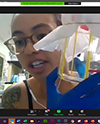 ENVISION PhD Students Use the Science of Breadmaking to Attract Franklin Eighth Graders to STEM
ENVISION PhD Students Use the Science of Breadmaking to Attract Franklin Eighth Graders to STEM
November 20, 2020
You pull a couple of slices of bread out of the bag. You slather them with peanut butter and jelly, or construct a BLT, then take a big bite. But did you ever wonder how flour is transformed from loose powder to semi-structured slices that can hold sandwich fixin’s? Exactly what is the science behind breadmaking?
During fall 2020, four Illinois engineering PhD students, Emil Annevelink, James Carpenter, Drew Kuhn, and Aleczandria Tiffany, did a Zoom outreach at Franklin STEAM Academy, a Champaign middle school whose focus is on STEAM (Science, Technology, Engineering, Arts, and Mathematics). The goal behind the October and November virtual visits was to impart the science behind breadmaking to Katie Lessaris’ eighth grade science classes. Members of ENVISION (ENgineers Volunteering In STEM EducatION), a Registered Student Organization whose sole purpose is to provide opportunities for engineering grad students to do STEM outreach, the PhD students sought to not just communicate science, but to share how they ended up in engineering, serve as role models in that they too had overcome challenges, and to foster the middle schoolers’ interest in STEM. Of course, the fact that sourdough bubbles and smells added to the fun!
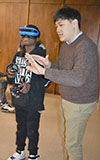 Franklin Steam Academy Students Experience Cutting-Edge Science at MRL
Franklin Steam Academy Students Experience Cutting-Edge Science at MRL
February 27, 2020
Explore a different reality via VR. Cover up from head to toe in a strange suit, safety glasses, and gloves and experience a cleanroom. See firsthand what equipment like a 3D Optical Profilometer and a Contact Angle Goniometer do. These are just some of the cool things Franklin STEAM Academy students got to experience during their field trip to the Materials Research Lab (MRL) on February 20th (the 7th graders) and 21st (the 8th graders). During their brief hiatus from the classroom, the students not only got to see, but get their hands on, some real-world, high-tech stuff MRL scientists use every day in their research.
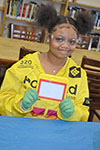 Musical Magnetism’s Destroy-A-Toy Activity: Messy, But Definitely Curiosity-Driven and Educational!
Musical Magnetism’s Destroy-A-Toy Activity: Messy, But Definitely Curiosity-Driven and Educational!
February 13, 2020
The challenge for the Franklin STEAM Academy seventh and eighth graders participating in the Musical Magnetism’s Destroy-A-Toy, hands-on activity was to discover what makes toys like a Magnadoodle or an Etch-a-Sketch work. After all was said and done, they learned that it was magnetism. (After all, in a program called Musical Magnetism, it’s apparent that either one or the other must be involved.)
 Putting the A in STEAM: Franklin Students Make Music Videos About Magnetism Via I-MRSEC’s Musical Magnetism Program
Putting the A in STEAM: Franklin Students Make Music Videos About Magnetism Via I-MRSEC’s Musical Magnetism Program
January 21, 2020
What better way to get Franklin STEAM Academy seventh and eighth grade students interested in science than by couching it in fun, hands-on activities and demonstrations and encouraging them to express what they’ve learned in some mediums they love—music, hip hop/rap, and videos. This was the goal of the Musical Magnetism program sponsored by I-MRSEC (the Illinois Materials Research Science and Engineering Center), Illinois’ NSF-funded center which focuses on some of the properties of materials, such as magnetism. The main project of the Jan 13–March 6, 2020 program is this: students are to select a specific topic related to magnetism, research it, then create a music video to be previewed at a video release party on the final day of the program.
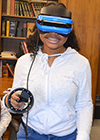 Franklin Steam Academy Students Experience High-Tech Science at MRL
Franklin Steam Academy Students Experience High-Tech Science at MRL
March 27, 2019
On February 25th, Franklin STEAM Academy eighth grade students took a break from their science textbook to experience some real-world, high-tech science first hand during a visit to MRL (the Materials Research Lab), home of I-MRSEC (the Illinois Materials Research Science and Engineering Center). The field trip was one of the highlights of I-MRSEC’s “Musical Magnetism,” a multi-disciplinary curriculum that used rap and music to expose students to materials science and magnetism. At MRL, the university folk pulled out all the stops, proudly introducing the youth to some of their million-dollar equipment and exposing them to some of the cool stuff they do—all while practicing another of I-MRSEC’s main emphases: scientific communication.
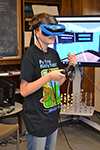 I-MRSEC’s Musical Magnetism Curriculum Uses Hip Hop to Teach Science
I-MRSEC’s Musical Magnetism Curriculum Uses Hip Hop to Teach Science
March 12, 2019
It’s not your mother’s science class…or music class, for that matter! The goal of I-MRSEC’s “Musical Magnetism” curriculum was to expose Franklin STEAM Academy eighth grade students to materials science and magnetism, but also to another of the center’s main emphases: scientific communication. What’s unique about the lesson plans is that they embraced a medium today’s kids can probably get into: hip hop or rap. So, after a number of Illinois researchers, students, and staff, who also served as role models, had exposed the students to multidisciplinary lessons in several related areas, the kids teamed up to create then present raps about specific areas of magnetism.
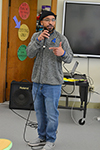 I-MRSEC, Champaign Educator Jamie Roundtree, Embrace Hip Hop/Rap to Reach Youth at Their Level
I-MRSEC, Champaign Educator Jamie Roundtree, Embrace Hip Hop/Rap to Reach Youth at Their Level
Feburary 14, 2019
“So if you can find value and show value for what students value, then they are going to find value in the things you are asking them to value.” – Jamie Roundtree
While some folks might insist that Hip Hop or rap doesn’t belong in the classroom, some of those involved with I-MRSEC’s Musical Magnetism curriculum, including Champaign Unit 4’s Director of Elementary Teaching and Learning, Jamie Roundtree, would disagree. They’re using the medium as a way to teach the students at Franklin STEAM Academy about, and get them engaged with, science—specifically magnetism. As part of the multidisciplinary curriculum, students are creating a rap song about one of a number of principles related to magnetism.













.jpg)















